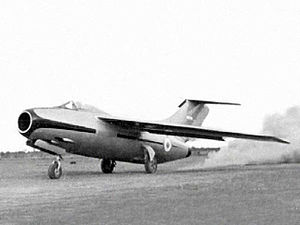FMA IAe 33 Pulqui II
| IAe 33 Pulqui II | |
|---|---|
 |
|
| Pulqui II (No. 02) c. 1950 | |
| Role | Fighter/Interceptor |
| Manufacturer | Fábrica Militar de Aviones (FMA) |
| Designer | Kurt Tank |
| First flight | 27 June 1950 |
| Retired | 1960 |
| Primary user | Fuerza Aérea Argentina |
| Number built | 5 (1-static test, 4 flying prototypes) |
| Developed from | Focke-Wulf Ta 183 |
The FMA IAe 33 Pulqui II (in the indigenous language Mapuche, Pulqúi: Arrow) was a jet fighter aircraft designed by Kurt Tank in the late 1940s in Argentina, under the Perón government, and built by the Fábrica Militar de Aviones (FMA). Embodying many of the design elements of the wartime Focke-Wulf Ta 183, an unrealized fighter project, the FMA envisioned the IAe 33 Pulqui II as a successor to the postwar Gloster Meteor F4 in service with the Fuerza Aérea Argentina. The Pulqui II's development was comparatively problematic and lengthy, with two of the four prototypes being lost in fatal crashes. Despite one of the prototypes being successfully tested in combat during the Revolución Libertadora, the political, economic and technical challenges faced by the project meant that the IAe 33 was unable to reach its full potential, and the Argentine government ultimately chose to purchase F-86 Sabres from the United States in lieu of continuing development of the indigenous fighter to production status.
In the late 1940s, Argentina benefited from the recruitment of prominent German aerospace scientists and engineers, fleeing Europe following the defeat of the Nazis and seeking sanctuary in Latin America. The first group of these refugees had also included French designer Émile Dewoitine, castigated as a collaborator in his homeland, who headed the IAe 27 Pulqui I experimental fighter program with Argentine engineers Juan Ignacio San Martín, Enrique Cardeilhac and Norberto L. Morchio. The Pulqui I was the first jet aircraft designed and built in Latin America. In 1947, flight tests revealed a mediocre performance resulting in the cancellation of the IAe 27 program. The Aerotechnical Institute (Spanish: Instituto Aerotécnico), under the leadership of Morchio, persevered with its efforts to build a successful indigenous jet fighter and, at first, attempted to modify the earlier aircraft. When it became apparent that the Pulqui I had little potential for further development, the Aerotechnical Institute initiated a new design utilizing the more powerful (20.31 kN (4,570 lbf)) Rolls-Royce Nene II turbojet engine. In early 1948, the Institute completed a scale model of what it called the IAe-27a Pulqui II. This design featured trapezoidal wings, swept back at an angle of 33°, and used a NACA 16009 laminar flow airfoil section. A revised model was built later that year with the wings relocated to a shoulder-mounted position and the tailplane changed to a T-tail configuration.
...
Wikipedia
